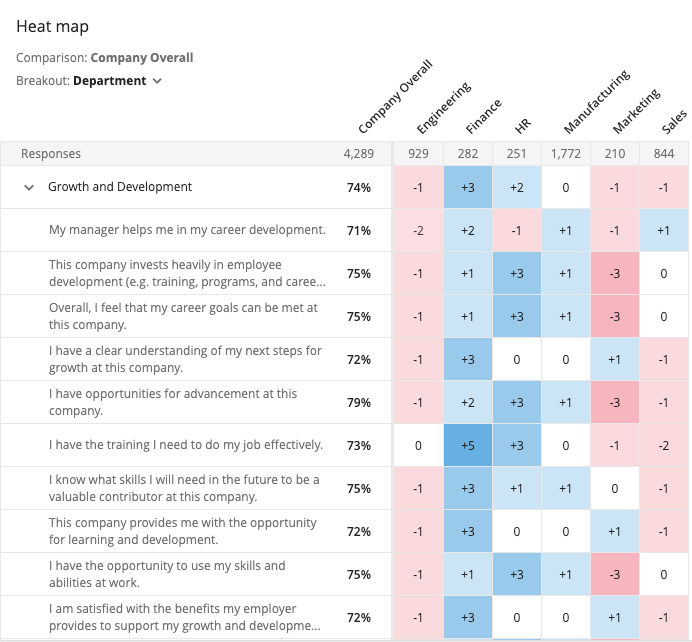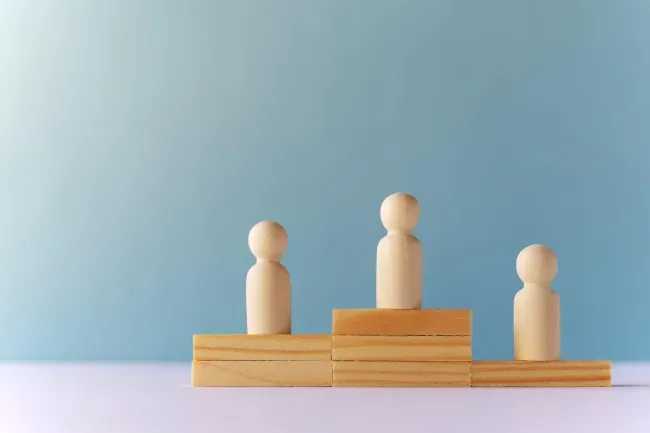Intro
There’s so much more to being an employee than working through tasks, ticking off the ‘to do’ list, and doggedly scaling the corporate ladder. Today’s employees need a whole raft of skills, confidence, adaptability, and meaningful goals to develop careers that are truly fulfilling.
But all this doesn’t just happen by osmosis. Everyone needs a plan to keep them on track professionally, and personally too. Personal development plans (PDPs) are a way to give employees structure and meaning so that they can see the way forward at work, and thrive.
Let’s look at why personal development plans matter and how to create ones that really work for your employees.
What is personal development?
It’s worth taking a moment to consider what we really mean by ‘personal development’. It’s far more complex than simply getting better at your job, encompassing:
Learning new skills
Specialist and technical ones specific to a job role, and ‘soft skills’ such as communication, teamwork and critical thinking for the wider workplace.
Becoming adaptable
The world of business is in a constant state of flux, so learning to be resilient and open to change is essential.
Learning to lead
You don’t need to aspire to be the CEO to develop leadership qualities; anyone can develop decision-making, mentorship, and accountability skills.
Building trust and engagement
Everyone can learn how to contribute, collaborate and develop good working relationships.
A thirst for lifelong learning
Staying curious, interested, humble, and open to every available educational opportunity.
The main thing to remember about personal development is that it isn’t just a one-off event; it’s an ongoing development journey, building and being added to indefinitely.
What is a personal development plan?
Instead of an employee simply waiting and hoping for career development, their own personal development plan is dynamic – a structured roadmap to help them to grow and achieve their ambitions.
It usually includes:
Career goal setting: what do I want to have achieved in a year’s time? In five years? Maybe even more.
Strengths and weaknesses: What am I good at? What do I really need to work on?
Opportunities: What do I need, in the way of training, courses, practical experience or mentorship?
Action points: What do I need to do, incrementally, to reach my goals?
Timeline: When do I need to do it by? Plans need to be time-bound so they don’t meander on indefinitely.
Regular check-ins with leadership: How am I doing? Essential for checking progress and making sure the plan is on track.
What are the benefits of personal development plans?
Employee engagement
You’ll want your workforce to be engaged, and having the best possible employee experience. It has been long known that companies with engaged employees are 21% more productive, 22% more profitable and score 10% higher ratings, with fewer negative business outcomes.
Understanding how employees can grow and develop always comes out as one of the top drivers of engagement, intent to stay, well-being and inclusion, and setting personal goals positively impacts on employee experience by giving people targets to work towards, achieve and celebrate.
It keeps employees engaged with learning, encourages self-reflection, and helps them stay proactive rather than reactive in their development.
Self-awareness
Self-awareness is a major influence on personal development. It involves exploring thoughts, emotions, beliefs, stresses, and confronting ‘good’ and ‘bad’ traits, among other things.
The personal development plan is the ideal tool for increasing employee self-awareness because it encourages intentional reflection on current skills, goals and experience gaps. It’s in effect a structured way for employees to get to know themselves better.
Self assessment encourages employees to:
- Self-reflect honestly: a PDP makes them take stock of where they are now, what they are good at, and what they need to work on
- Clarify their personal and professional goals: instead of vague ambitions, employees define clear objectives, cutting through the everyday ‘noise’ and zoning in on what is really important for them
- Spot patterns in behaviors and decision-making: by tracking progress with PDPs, recurring habits and challenges that either help or hinder development soon become apparent
- Get external perspectives: a PDP can help employees see themselves as others see them, particularly if you use 360-feedback or a mentorship program, increasing awareness of how they impact those around them.
Continuous growth and career advancement
A personal development plan (PDP) keeps professional growth from being a one-time effort and turns it into a continuous journey. By setting clear goals, tracking progress, and adapting it if necessary, a PDP ensures employees are always evolving. Over time, this steady, intentional growth boosts confidence, resilience, and adaptability, making it easier to navigate inevitable career shifts and challenges – and the possibility of promotion, or a new, even more fulfilling role.
Increased confidence
That lovely feeling of knowing what you need to achieve, being able to get on with it, and seeing yourself make progress that a PDP gives is also a great confidence boost. Recognizing strengths, overcoming challenges and learning new skills in a structured way gives employees self-confidence. Self-reflection soon turns into self-belief which helps employees embrace challenges and opportunities with certainty and resilience. PDPs make sure that this confident growth is continuous.
How to create a personal development plan
When you create professional development plans for employees to use, you’ll first need to take the following things into consideration:
Putting hopes, dreams, strengths, weaknesses and career path ambitions onto paper for the HR department is a soul-baring moment for some employees, who may feel somewhat vulnerable doing it. Therefore it’s imperative that the environment is sufficiently supportive and inclusive for employees to feel psychologically safe enough to reveal what they want to do in the future, and be sufficiently encouraged to pursue their professional development goals.
PDPs aren’t set in stone, particularly in an agile, dynamic working environment. Make sure yours are flexible and adaptable enough to accommodate fluctuating employee and organizational needs and goals.
Make sure individual PDPs are aligned with clear business objectives so that the employee develops in exactly the right way to get their particular job done.
Key components of the best personal development plans are:
1. Ascertain goals
What does the employee want to achieve? This could be the completion of a project, a promotion, a sideways move into another department, a new skill, or professional qualifications.
You can use 360-feedback to set the personal development goals. Because it’s based on real feedback, it provides clear indications about where to focus the development efforts.
2. Assess the current situation
This is where self-awareness and reflection come in. The employee takes an honest look at where they are currently: their skill level, their strengths, their experience gaps and anything that needs improving.
360-feedback is once again useful here as a development tool as it helps individuals understand their personal strengths and weaknesses, using the constructive feedback of others who work with them the most.
This is like asking, “What’s working for you, and what’s holding you back?”
3. Set clear, achievable goals
Learners who set career goals engage with learning 4x more than those who don’t set goals. Big personal and professional aspirations are welcome here, but make them manageable by breaking them down into smaller, achievable milestones.
And each goal needs to be a SMART one ( Specific, Measurable, Achievable, Relevant, and Time bound).
4. Identify the workplace skills needed
To achieve the goal, what does the employee need to learn? Learning comes in many forms: from training, courses, mentorship, or hands-on experience, to improving communication, teamwork, leadership development skills, or technical know-how.
5. Resource the employee
Do they need specific tools, software, workshops, subscriptions, books, fieldwork or networking opportunities? Does your organization offer suitable professional development programs? If so, get your employees on them.
6. Create an action plan
This is where the PDP gets practical; what needs doing, and when, to achieve the goals. Maybe the employee is attending a weekly seminar, or a monthly session with a mentor from senior leadership. Schedule this all on the action plan.
7. Keep track
An untracked plan has a habit of overrunning, being sidelined, or at worst, ignored. To keep employees accountable for sticking to the plan and working towards their goal, you need to measure progress (you can get apps for this) and review regularly, with feedback. There’s nothing more satisfying – and engaging – than seeing how far they’ve progressed with their career aspirations.
8. Prepare to make adjustments
It’s a rare development plan that doesn’t need tweaking in the light of feedback and the actions that may need to be taken in response to it. Because personal growth is rarely a straight path and life gets in the way, the employee may need to make some adjustments, seize some opportunities and refine their plan.
Personal development plan template
You don’t have to create a personal development plan on paper any more (unless you want to). And it’s best to encourage employees to take ownership of their development and design their own.
There are plenty of solution-based templates out there such as the Qualtrics Employee Experience Management solution to improve your employees’ experience by increasing access to opportunities for skills development, personal and professional growth, and coaching.

Image: https://www.qualtrics.com/marketplace/employee-growth-development/
You’ll be able to:
- Access prebuilt personal development plan templates for easy distribution, real-time data analysis, and easy-to-use reports or dashboards
- Identify the gaps in your existing employee growth plan and development initiatives; you’ll also see areas for improvements and investments to have the biggest impact on your people.
- Use intelligent employee development program design, combining best practices, easy distribution, and standardized reporting and dashboards
- Gain valuable insights from your professional development plans and actionable steps faster.



